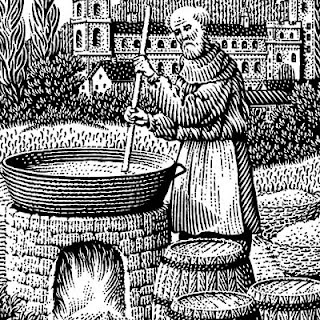Yeasts are a fungi with 1,500 different species. One species
in particular, Saccharomyces cerevisiae, has been used for thousands of years
in baking and alcoholic beverages. Through the process of fermentation,
carbohydrates (starches or sugars) are converted into alcohols and carbon
dioxide. Carbon dioxide is what makes bread leaven by creating air pockets in
the dough, carbon dioxide gas is also used to create...Pop Rocks! The alcohol
is the product of yeast that is important in beer. However, the spent yeast
itself lends a flavor and aroma to beer.
 |
| Bread leavened by carbon dioxide from yeast |
Brewing yeasts can be classified as "top-fermenting"
or "bottom-fermenting." Top fermenting yeasts got their name because
they produce a foam at the top of the wort (liquid extracted from mashing) during
fermentation. Dependant on the style of beer you are producing, you may decide
to purchase a certain strain of yeast. Top fermenting yeasts are used in
brewing porters, ales, stouts and more. Bottom fermenting yeasts are used in pilsners,
bocks and more. Other than the carbon dioxide and alcohol that yeast produces, it
can also leave behind other flavors and aromas such as butterscotch, sulfur, or
green apple. Learn more about top and bottom fermenting yeasts and yeast flavors.
 |
| Head (foam) of a beer |
Yeast can be purchased in many different forms: liquid, pressed,
crumbled, active dried, and instant dried. When I used to work making fresh pizza
dough in a restaurant, we would always use pressed yeast because it was shipped
in blocks and the proper amount (1/2 a brick) could easily be thrown into the
mixing bowl. Click to learn more about these different forms of yeast.
Any cereal (edible component of grain) containing sugars can
undergo fermentation due to wild yeasts in the air. As far back as 7000BC,
Chinese villagers were producing alcoholic drinks. Beer was part of the daily
diet of Egyptian Pharaohs over 5,000 years ago, it was made from baked barley
bread and was used in religious practices as well. Tutankhamum Ale is limited edition beer has a very interesting past. It was brewed in the basement of the laboratory of Cambridge from a recipe that was discovered at Queen Nefertiti’s temple in Egypt. Average retail for this beer is $52 per bottle. Learn more here!
 |
| Tutankhamum Ale |
Certain yeasts can be used in microbial fuel cells, and
other types are pathogens that can cause infections in humans. Yeast cells are also used to do genetic
studies, as they have similar features to human calls. They can be engineered
to produce proteins which can be used to treat human disease. Yeast is often
taken as a vitamin supplement because it is 50% protein and a rich source of B
vitamins. Yeast sure is a magical fungi!
When brewing beer, have you ever used liquid yeast? We Want to hear from you








